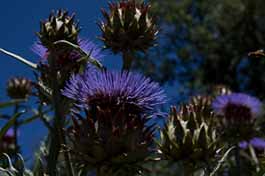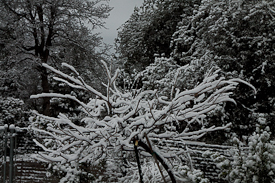| |
The monthly growing cycle in Victoria Garden
January.
January is the resting period for the garden. Night frosts stopped nearly all growth and diminished the amount of flowers to a bare minimum. The short days are frequently dark and rainy.
In January we can expect episodes of what they call here 'rain storms'. No strong winds need to be involved, but the clouds certainly will drop buckets of water nonstop for days. This year we definitely had our share of rainfall. All those dark wet days, being locked up in my workroom, I had to remind myself of the positive side of this rain. After years of drought, the frightening wild fires close by and nearly having water restrictions last summer, we needed this rain. Luckily the surrounding lakes are nicely filling up.
In the garden the seasonal creek starts to run and through the windows I enjoy watching the little waterfalls. The annual grasses like the wet atmosphere and the look just as fresh and green as they do in summer in Northern Europe. Together with the ever-greens and ever-grays they give me a joyful spring feeling.
In between the 'rain storms' we also have some lovely sunny days with temperatures up to 65 degree (18 Celsius). On those days you can sit in the garden and my fingers itch to start clearing up. But I know, I have to be patient. It is not spring yet! We still can expect some 'heavy' night frost. I know elsewhere people would laugh about 23 degrees (-5 Celsius) but it is enough to kill lots of plants and I better leave them protected by their old foliage.
To see photos of the garden on January 26th 2010 click here.
February.
February is a winter month, but here in the second half of February the garden starts to awake. Night frost may still occur, but the days start to lengthen and the day temperatures can become higher. Days with temperatures in the high sixties (about 22C) make your hands restless and drive you outside to start working in the garden. Lots of tasks are waiting. Removing last year's dead wood, pruning, weeding etc.
In the garden the new flower season start. The Helleboris, Primula and Violets, Hyacinth's, Narcissus and Dutch Irises flower.
It is also the time that plants start to leaf out. Roses look now so fresh with their new
leaves. Something to remember in the hot summer months. Specially after rain the Heuchera's,
Golden Feverfew, Antirrhinum 'Black Prince' and the Euphorbia color the garden with their leaves.
All these little gems can be seen here.
March
Beginning March the day temperatures begin to rise and the perennials start to show that they still exist and carefully stick their heads above the soil. Most of the pruning and removing lasts years dead wood has been done and the garden looks promising. Still the nights are cool and night frost can occur. The plants are cautious and grow only slowly.
This month is for all the heyday of the Daffodils, which do so wonderful in our Redding climate. In all combinations of yellow, white and orange they display, one after the other, they display their jazzy trumpets.
Approximately end of March the trees in Victoria Garden start to leave out, marking the real start of spring. The new leaves of the Blue Oaks and the flowers of the Interior Life Oaks, color nature light green and we know that from now on everything starts growing rapidly. With still rain coming regularly and the temperatures creeping on average above 64 degrees (18 Celsius) the growing time starts and many more early plants begin to flower.
To see the March flowers click here.
April
 April is the month of greens, grays and chartreuses. It is the time that the perennials grow rapidly and the leaves texture dominant and color the garden. Even without one flower, the garden is rich in color. After the rains the chartreuse leaves of the Feverfew, the huge deeply lobed gray leaves of the Cardoon, the brown and orange elegant grasses compete for your attention with the late spring flowers, like Azaleas, early Lavenders, Irises, Roses, Columbines, Wall Flowers and late spring bulbs, like tulips and Blue Bells. April is the month of greens, grays and chartreuses. It is the time that the perennials grow rapidly and the leaves texture dominant and color the garden. Even without one flower, the garden is rich in color. After the rains the chartreuse leaves of the Feverfew, the huge deeply lobed gray leaves of the Cardoon, the brown and orange elegant grasses compete for your attention with the late spring flowers, like Azaleas, early Lavenders, Irises, Roses, Columbines, Wall Flowers and late spring bulbs, like tulips and Blue Bells.
The garden is lush and during the heat of summer we will long back to the April mornings when the sun just appeared after the endless 2010 rains and lightened up the raindrops which made this abundance of growth possible.
May 
In May Victoria Garden starts to look mature. The perennials are still growing and gaining height by the day. The garden transforms completely. Some herbaceous plants, like Poke, which were hardly visible a month ago now rocket into the sky and reach a height of 5 feet easily. The chance of night frosts is over and all the annuals have been planted. These flower powers will definately add their charm to the garden till maybe mid December. Every year I am surprised by the transformation from the spring garden into an early summer heaven, which is marked as well by the growing diversity in color. One by one, plants open their flowers and add their color shades to the riches of the garden. It is a joy to walk around and see a new surprise every day.
June
 In June the peak of flower performance occurs. A crop of hundreds different flowers can be seen. Bees, butterflies, hummingbirds, beetles, all kinds of insect busy around to collect the nectar, available in abundance. Some plants offer an elegant landing platform with their Daisy like flowers, much appreciated by butterflies. Others have trumpet formed flowers, more suitable for the hummingbirds. Some birds are attracted by the nectar while others feed themselves on lice and other critters. Not only the flowers are useful, the bushes provide a hiding place for Quails. Lots of Salamanders are sunning on the stones, rocks or gravel paths along the borders and nourish themselves on many insects living under and on the garden vegetation.
In June the peak of flower performance occurs. A crop of hundreds different flowers can be seen. Bees, butterflies, hummingbirds, beetles, all kinds of insect busy around to collect the nectar, available in abundance. Some plants offer an elegant landing platform with their Daisy like flowers, much appreciated by butterflies. Others have trumpet formed flowers, more suitable for the hummingbirds. Some birds are attracted by the nectar while others feed themselves on lice and other critters. Not only the flowers are useful, the bushes provide a hiding place for Quails. Lots of Salamanders are sunning on the stones, rocks or gravel paths along the borders and nourish themselves on many insects living under and on the garden vegetation.
A delicate cycle of all kind of animals eating and being eaten is made possible by the great variety of plants and at the same time this cycle protects the plants from being wiped out by insects. Just let nature takes its course and we as gardeners can relax
and enjoy our summer heaven.
July and August
In July and August the heath strikes merciless and the garden takes a summer nap. Most plants put all their energy in just surviving and wait with putting up new flowers, till the days cool off again. Now we know why we planted all those annuals, like zinnias, petunias and snapdragon. They are not impressed by the summer heath and flower continuously. It also the flowering season for all rudbeckias, scabiosa and phox. Annuals like poke and Caster beans show their dark red and black fruits at a dazzling height of 15 feet above the other plants making sure they will be back next season.
 September
In the second part of September it starts to cool off and a second "spring" sets in. Plants start growing again and form new leaves and flowers. They still needs time to recuperate from the summer heat, but the garden becomes more colorful and the fall plants join the other plants with their blossoms.
October
 In Redding I would consider October CA the last phase of a long summer. Temperatures are now back to what one in England and the Netherlands would consider a hot summer day. Slowly the first rains start and you see the garden "greening up". Roses start to flower again and some years give till the end of November even more flowers than in the months June and July. All around the garden the native grasses start to grow and add to the spring feeling. In Redding I would consider October CA the last phase of a long summer. Temperatures are now back to what one in England and the Netherlands would consider a hot summer day. Slowly the first rains start and you see the garden "greening up". Roses start to flower again and some years give till the end of November even more flowers than in the months June and July. All around the garden the native grasses start to grow and add to the spring feeling.
Till frost arrives end of November the annuals with their abundance of flowers
prove once more why it is worth having them in the garden.
November
 November is amazing how many plants still flower in November. The temperatures during the daytime are still relatively high and you often don't need a coat. But the nights are getting much cooler and fall starts. Reds, browns and yellows are starting to dominate the garden. The deciduous leaves are turning their colors before dropping on the ground. Actually I consider this the most colorful month in the garden. November is amazing how many plants still flower in November. The temperatures during the daytime are still relatively high and you often don't need a coat. But the nights are getting much cooler and fall starts. Reds, browns and yellows are starting to dominate the garden. The deciduous leaves are turning their colors before dropping on the ground. Actually I consider this the most colorful month in the garden.
When the leaves start dropping most people will blow them quickly away to clean the garden. But they don't see the beauty of the leaves. The leaves maybe not so good for a lawn, but they will protect tender plants in the borders. They also will form a good compost for the plants in spring. So I just let them be and enjoy their beauty in between the plants in the garden.
 December December
In the first half of December the last fall colors slowly disappear. It becoming colder, especially during the nights. All the tender plants have been lifted and brought into the greenhouse. What is left must endure the night frost and some years we have a few nights which makes me very clear again that Victoria Garden in winter belongs in zone 7.
Still lots of beauty to be seen in the garden. The decaying leaves, mushrooms and old seed heads give the garden a special atmosphere. We even can expect some snow. But hurry if you want to take some nice photos, it will melt in no time.
Even in this coldest month of the year, the promise of a new season can be seen as well. Bulbs start already to put their heads above the ground and some plants like
Primulas, Manzanitas and Arbutus unedo (Strawberry Tree) show with their flowers,
that the new plant cycle is starting already.
|
|